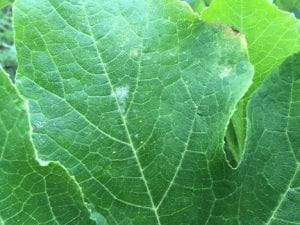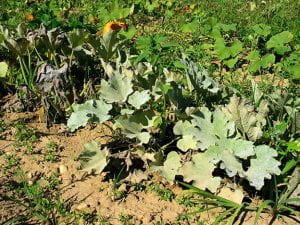Abby Seaman, Bryan Brown, Marcus Lopez
Powdery mildew, a fungal pathogen that lives on the surface of leaves, sending little feeding structures into the leaf to absorb carbohydrates and other nutrients, is the predominant disease in winter squash production. It occurs every season in both summer and winter squash, as well as pumpkins (many varieties of cucumber and melon are resistant), and unlike many fungal plant pathogens, is inhibited by leaf wetness. Instead, high humidity is what favors powdery mildew.
Powdery mildew reduces crop yield and quality by causing leaves to die prematurely, which results in smaller and less-sweet winter squash. Resistant varieties and fungicides are the main methods for controlling powdery mildew. Bush Delicata, the variety we’re growing in our trial, has some tolerance. Half of each of our plots is being treated for insect and disease pests with insecticide or fungicide that is allowed for certified organic production. Because the pathogen produces a lot of spores and increases quickly once infection starts, the recommended threshold for starting fungicide applications is one infected leaf per 50 leaves scouted.
We used a potassium bicarbonate product in this trial, but there are other allowed products that have been shown to be effective, including botanical oils and soap-based products. We’ll be comparing yield and quality (soluble solids in the fruit) between our treatments and between our treated and untreated subplots. Our scouting so far has shown lower levels of disease in our treated plots.
Learn more about cucurbit powdery mildew here.

Powdery mildew just getting started

Powdery mildew completely covering leaves. Photo by Dr. Meg McGrath, Cornell University.
